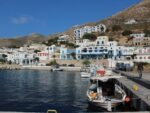Amorgos Eastern most of the Cyclades


Overview & Reasons to visit
Amorgos is the furthest east of the Cyclades and is one of the larger islands but consists of only two ports, a Chora and a single road. The single road between the ports of Katapola and Aegiali is a relatively recent addition. Previously the easiest way to travel between the ports was by boat which is why many of the ferries call at both. All of the places on the island are quiet and almost old-fashioned unhurried atmosphere and seems to have attracted an artistic community. Katapola is the main port and has a good selection of accommodation and tavernas with several beaches nearby. People & boat watching is a popular occupation in Katapola!
Aegiali is the second port and is actually 4 small villages and is developing as a beach resort and has a selection of tavernas, shops and other amenities. Aegiali is an ideal laid-back beach resort
Chora is situated in the middle of the island and its isolated position is due to the attention of pirates during the Byzantium and Ottoman periods it is a mixture of narrow streets and small squares with a ruined Venetian castle overlooking it.
The spectacular Monastery of Panagia Hozoviotissa is a unique and awe inspiring sight on the road to the south of the island.
Amorgos was used in the plot and filming of the French cult diving film Le Grand Bleu
Walking holidays are becoming a feature of Amorgos with a series of trails, the Blue Paths.
How to reach
There is not an airport on Amorgos so only access is by boat
Blue Star Ferries serve both ports on the island from Piraeus on daily basis but best way to get there is by the local Express Skopelitis ferry which is based at Katapola and connects with Naxos vis the other small Cyclades islands 6 days a week. This ferry also goes to Aegiali.
Seajet have a daily service from Piraeus via Santorini
It is also possible to arrive from Rhodes via Astipalea.
Travelling Around
There are limited bus services between Katopola, Chora and Aegiali and occasional buses to the Monastery and Kalotaritissa. There is also an island tour bus trip from Aegiali.
There are 3 car rental companies and they have offices in both Katopola & Aegiali.
Taxis are available but are few in number unsurprisingly
Sights & Beaches
There are several beaches around Katopola including St Panteleimon Beach with its picturesque which can be accessed by walking around the bay.
There is a good sandy beach at Aegiali and more beaches further around the bay along a path
Agia Anna beach is off the road from Chora to the south of the island near to the Hozoviotiss Monastery.
Kalotaritissa beach is at the end of the road from Chora to the south and is a large sandy beach, you pass the wreck of a ship in one of the bays on the way. The Olympia was wrecked in 1980 and features in the film Le Grand Bleu.
The spectacular Monastery of Panagia Hozoviotissa can be found of the road from Chora to the south it clings to the cliff face in a seeming impossible way it is 300 meters above the sea, its length is 40 meters and its width is just 5m! It is open to visitors provided you are happy to climb over 300 steps to reach it from the small car park. Strict dress code is enforced. It was built in 1088 to commemorate an icon of the Virgin Mary which is believed to have come from Hozova in Palestine. It was rebuilt in Byzantine times and during Venetian era.
Chora is the capital of Amorgos and is a pretty whitewashed mountain village overlooked by a mediaeval Kastro and surrounded by windmills with small shops and tavernas in a scatter of narrow streets to explore.






History
Amorgos has been inhabited since the Early Cycladic Period (3rd millennium BC) and through the Minoan and Mycenaean periods during this time there were 3 important cities on the island: Minoa, Aegiali, and Arkessini. Amorgos was allied to Athens then in 337 BC Macedonians took it over and in 322 the Macedonians won the naval battle of Amorgos against Athens
The imposing monastery of Panagia Chozoviotissa, on Mount Profitis Ilias in the 11th century, is the most important monument of the Byzantine era.Following the Byzantines Amorgos suffered predation by pirates causing the desertion of onshore settlements and the movement of populations settlements in the interior. In 1309, it joined the Duchy of the Aegean Sea followed by occupation by Venetian nobles, Catalans and Ottomans up to 1537 then Hayreddin Barbarossa took over the island. The Ottoman Sultan ended this long period of instability.
Amorgos played an active part in the 1821 Greek War of Independence with its naval power. In the 19th century, many inhabitants of Amorgos migrated to Athens to work as builders and stone-cutters this resulted in the decline of the island. During Metaxas’s dictatorship , the island was used as a place for exile. In 1941 Amorgos came under Italian then in 1943 the Germans ruled until ally liberation in 1944.
